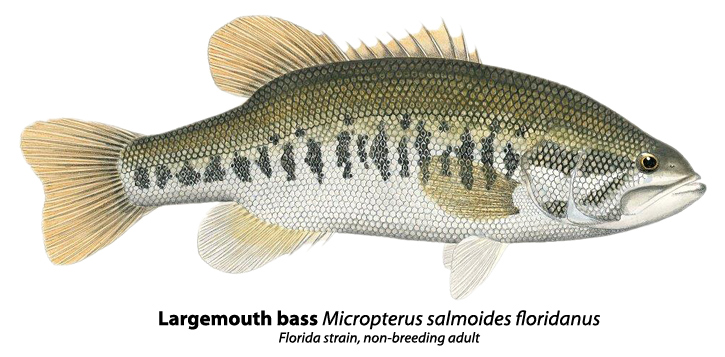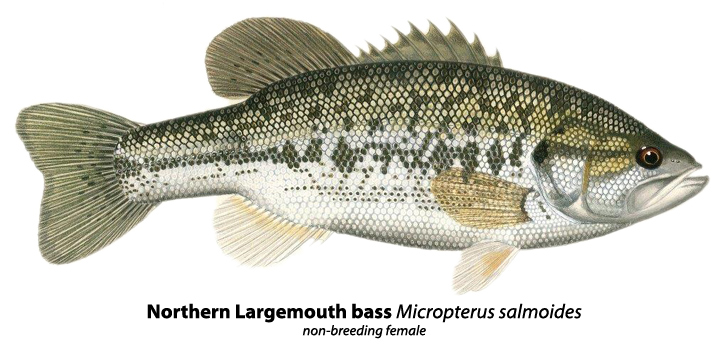Largemouth Bass, May 2015, Fish of the Month!
Well folks, those of you who prefer quarry larger than our American small Sunfishes will be happy to know that, with these entries, we leave the little guys behind and move into the realm of fish that are not typically thought of as being members of the Sunfish family. We're now in the realm of the North American basses (the genus Micropterus).
Northern Largemouth Bass
Micropterus salmoides salmoides
Florida Largemouth Bass
Micropterus salmoides floridanus
Local Names:
Black bass, Largemouth, Bigmouth bass, Green bass, Mossback, Mud bass, Straw bass, Slough bass, Oswego bass, Florida bass
Average Size:
Northern, 12 to 18 inches 1 to 3 pounds
Florida, 15 to 22 inches 1 to 5 pounds
Occasionally much larger in both subspecies.
Distinguishing Field Marks:
(See the illustration.)
-
The 2 subspecies of Largemouth bass are very similar to one another (see illustrations), but can be distinguished from the Smallmouth bass and its close relatives by the obvious notch between the 2 dorsal fins and the length of the upper jaw which, in the Largemouth, extends back beyond the rear edge of the eye.
-
The Florida Largemouth subspecies can be distinguished from the Northern by the lack of markings on its fins and upper back.
-
The Florida subspecies has smaller scales than the northern subspecies.
The Florida Largemouth bass can be distinguished from the Spotted bass by its lack of rows of spots below its lateral line.
North American Range:
Map to the right shows approximate range in North America.
Diet:
Very young Largemouth bass feed on all available plankton species, but soon include larger aquatic and terrestrial invertebrates in their diet. Adults consume a very broad range of foods. Although this diet consists mainly of fish, crayfish, frogs, snakes, small mammals, and occasionally even young waterfowl are taken as well. In its southern range, Gizzard shad make up a large percentage of the Largemouth diet, especially in artificial impoundments.
Biology:
Largemouth bass spawn from late spring into mid, or even late summer. Largemouth nests are dug by the males in areas where there is a soft, often mud bottom and may be adjacent to logs in bull-rushes, reeds, or emergent vegetation. The nests often incorporate roots attached to the bottom and are usually no less than 30 feet apart. Largemouth nests are generally 6 to 8 inches deep and 2 to 3 feet in diameter. The males are very aggressive during nesting time and devote considerable energy to defending their territories. Females come into the prepared nest areas usually about a week after the makes. When a pair has self-selected, the two begin nudging, nipping, and swimming parallel to one another in the pre-spawning ritual. Spawning is typical of the large sunfishes, with the pairs circling the nest and then hovering over its center while the female turns onto her side with the male remaining upright as small numbers of eggs are released and fertilized, separated by intervals of circular swimming. Usually females will hold some eggs to mate with other males. For that purpose they move from one nest to another until they have released all their eggs. Females will usually spawn each year from ages 5 to 12 years. The number of eggs carried by each female can range from a low of about 2000 to a high of 100,000. The fertilized eggs are adhesive and attach to whatever they contact as they sink. The male aerates the eggs by fanning them throughout their usual 3 to 5 day incubation period. Hatching eggs usually produce from 5000 to 7000 fry per nest. These remain dormant in the nest while the male aggressively guards them for an additional week and, even after they have swum free and form dense schools, may remain with them for as much as a month. Of these large numbers of fry it is normal for only 5 to 10 of them to survive into their 2nd year of life.
Adult Largemouth bass tend to remain in relatively shallow water, retreating deeper only in very warm or winter weather.
Fly Fishing for Redeye Bass:
Simply stated; the Largemouth bass is the United States' most popular game fish, pursued by more anglers than any other species. It has been widely introduced far beyond its native range and now is found throughout the U.S., Mexico, and a bit of southern Canada. It shares waters with the almost equally broad ranging Smallmouth bass, but only rarely are the two species found in the same habitats. Smallmouths prefer rocky or gravel bottoms while Largemouths seek vegetation. Northern pike, Muskellunge, bullheads, and the smaller sunfishes are the usual co-inhabitants of Largemouth bass habitats. Largemouths will seek cover in warm weather or drop into somewhat deeper water during daylight hours only to re-enter the shallows to feed as the sun sets.
At any given time, Largemouth bass can be very willing or very unwilling to accept the fly-fishers' offerings. Their natural curiosity about anything that moves will occasionally attract them to small flies, but only occasionally. Large, often wind-resistant flies are the norm for Largemouth fly fishing, making the best rod choices for Largemouth bass fly fishing 7 to 9 weight systems. Long rods are not coin-of-the-realm for Largemouth bass. Nine foot rods with powerful actions are ideal. Since Largemouths often shelter in or near heavy vegetation, many Largemouth flies are tied with a heavy monofilament or light wire weed-guard. Unfortunately Largemouth bass taken in heavy cover often become entangled in it and subdued by it, making them dead weight at the end of the line, and making a powerful rod a necessity. However, if you can keep the fish you hook fish out of their favorite weed-beds, then you're assured some very satisfying fish-playing activity which will also be aided by the rod's inherent power. Hooked Largemouths will typically thrust their heads and bodies into the air with mouths wide agape and frantic shaking of their large heads in an attempt to dislodge (often successfully) whatever is stinging their mouths. These leaps are usually interspersed with strong runs for cover. Combined with its sometimes extra-large size, all these tendencies add up to making this species a fine game fish.
Probably once every month, or, perhaps even more frequently, an innovative fly tier will post up yet another of his or her latest bass-fly inventions…..Covering the very broad range of what Largemouths will eat, these flies can, and do, represent frogs, fish, mice, and then some, and, many are quite large indeed. For that reason, we're not herein making specific bass-fly recommendations for you. If you tie our own, there are several very good bass fly pattern books readily available. In addition to forming a basis for your bass fly tying, these make books can make excellent references for your developing your own favorite patterns. If you don't tie your own flies, and especially if you're a beginning bass angler, search the internet for bass flies to buy and select a broad-based entry level assortment as a reliable place to start.
Significance to Humans:
Commercially marketed with Smallmouths as "bass," Largemouth bass were harvested in the lower Great Lakes as late as 1936 when they were regulated as strictly a game fish species.
Recently the Largemouth bass has been the basis for countless competitive fishing tournaments in which the top prize winners will invest heavily in boats and tackle and travel hundreds of miles to participate.
The main importance of this species is as a game fish which annually generates millions of dollars into local economies.
It is also considered a good food fish, especially if it is properly prepared (skinning rather than just scaling Largemouth bass will remove what is often described as a "muddy" flavor) and not over-cooked.
Status:
Maintaining, or thriving depending on the quality of its habitats and quantity of its preferred foods.








